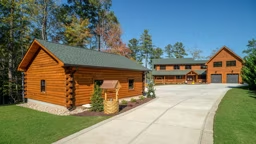
A bumped-out breakfast nook can be added to increase entertaining and living space in a log home.
We asked Jim Cooper, author of Log Homes Made Easy and a LEED Accredited Professional who consults in energy-efficient and sustainable building, to answer all of your questions about log home additions. Get his insights below:
Question: Is it easier to build a second level or add space to the main floor?
Answer:
That depends on a number of factors, including your building site, design of both your existing home and the proposed addition, and your budget. Because both options will likely affect the structure of your existing home, it’s important to discuss them with an architect, structural engineer or general contractor prior to construction.
One of the first considerations is how your existing home and foundation will carry the added weight. An architect, engineer or builder will first look at your proposed addition to determine how it will be supported, which may rule out certain possibilities either logistically or financially. Most foundations can handle the weight of a second level without much modification. A simple addition could consist of adding a couple dormers to turn attic space into usable square footage, which should keep demolition and cost reasonable. (It’s more costly to remove the entire roof and add a full second story because you pay both to demolish a perfectly good roof and then replace it.)
Two other factors to consider are how much time you’re able to leave the interior of your existing home exposed to weather and how you will access the upper level. In a dry climate during moderate weather, you may be able to handle being roofless for a couple weeks, but in most parts of the country, a lot of unpleasant possibilities can arise. Bad weather can damage your home, as well as extend construction time because outside work stops until decent weather returns.
Introducing a second level also means adding a staircase. A basic staircase requires an area roughly 12 to 16 feet long and 3.5 feet wide; if you’re short on space, consider inserting a landing to break the runs into shorter lengths. Expanding your main level is similar to building from scratch: Your addition will require its own foundation, walls and access to your existing home. Your builder will need to be concerned about how the walls and roof of the addition attach to the house.
If your site has the room, building out is usually less expensive than building up. Plus, building up means workers traipsing through your house and the noise of construction inside your home throughout the project; building out means the noise and activity take place mostly out of the regular flow of household activities.
Question: Is it difficult to match up logs? Is any special staining required to make sure they’re consistent with the rest of the home?
Answer:
Matching logs can be a challenge. Your existing walls may have had several years for logs to shrink and walls to settle. Joints between your new logs may initially match those in the existing walls when the addition is finished but be out of place after several years of shrinkage. Attempting to predict shrinkage and size logs is tricky because logs aren’t always predictable.
When adding a solid log addition to a solid log house, it’s best to set posts where the two meet and attach the logs to the post rather than each other. This allows the addition to respond independently to shrinkage and settlement. Points of attachment between the new and old buildings always pose some risks for air- and water-tightness, and energy efficiency. A weather-tight union requires skilled carpenters with experience working with logs.
Log additions also carry the challenge of blending the appearance of the existing logs with the new. Aged logs typically are darker than new ones. Stained logs may be difficult to match if the stain darkens over time. Isolating the new construction from the old with trim or other design features helps reduce potential differences in color.
Often the best solution for an addition is to use log siding over conventional framing or structural insulated panels (SIPs). Because log siding usually contains less moisture than solid logs, dimensions won’t change much, which improves the prospect of matching the log joints and makes it easier to create a tight seal.
Question: What precautions do I need to take if bearing walls are involved?
Answer:
Always talk to a structural engineer or builder before altering a bearing wall. Bearing walls carry part of the weight of your house and must be treated carefully to avoid injury to both you and your home.
Outside walls that rest on a foundation are almost always bearing. Interior walls can also carry weight. Check the basement or crawlspace beneath the wall in question; if there are walls or posts located directly beneath it, the wall is probably bearing. Also check the roof framing: Walls that cross at right angles with ceiling joists are usually bearing; walls beneath room-spanning pre-fabricated trusses often are not.
Removing a door or window to create access to your addition is fairly simple as long as you don’t widen the opening. In bearing walls, such features have headers that take the load from above and route it to either side of the opening. You can remove a door or window along with the piece of wall below the window without disturbing the structure. If you plan to widen the opening, however, you must install a new header after carefully installing temporary supports for the section of wall affected.
Question: Does shrinkage need to be taken into account? If so, how?
Answer:
Depending on the construction of your home and addition, shrinkage may be an important factor. If your home is solid log and fairly new, some settlement may be still occurring. This could strain connections to the addition and contribute to air and water leakage or structural issues.
If your solid log home is more than three or four years old, chances are most of the settlement has already taken place. However, adding a solid log addition introduces the possibility of settlement there. New walls may lose from 1 inch to several inches in height during their first years. This can create stress where the addition meets the house if the two aren’t joined properly.
To add an addition that may settle to an existing home that has finished settling requires skillful carpentry and familiarity with log construction. To avoid potential problems brought on by uneven settlement, try to isolate the log walls of the addition from the main home as noted previously to keep their settlement separate. Carpenters used to working with logs sometimes create slip joints that keep the wall joints tight as they settle. Building with the driest logs available also helps minimize shrinkage and settlement.
As an alternative, consider a timber-frame, conventional-frame or half-log-covered SIP addition to match the rest of the house. These systems don’t settle and should have little impact on your existing log home. It’s also easier to create a lasting, weather-tight union between your existing home and addition.
Question: My ceilings are tall enough to allow for a loft. What type of reinforcement is needed to support this log home addition?
Answer:
Adding a loft to a cathedral ceiling area can be an easy way to gain floor space. A loft floor consists of either heavy timber or conventional floor joists covered with sheathing and flooring. Depending on the length the joists will span, you may also need a girder beam supported by posts beneath it.
In the simplest loft floors, joist hangers attached to log walls support the floor joists. The joists are then covered with tongue-and-groove pine flooring. The joists may be dimensional lumber (2-by-10s or 12s) or heavy timbers (4- or 6-by-8s). Talk to a builder, architect or engineer to determine the proper size of the joists and the size and placement of additional supports. If your joist spans are 16 feet or less, you may be able to build your loft without supports.
Question: Any projects that are particularly challenging or should be avoided when adding on to a log home?
Answer:
With research and careful planning, your only limitations are your imagination and your budget. Architects and engineers often save you far more than they cost by recognizing potential pitfalls or unexpected possibilities. Check building requirements with local building officials. In many areas, you will need a building permit, as well as specialty permits, such as electrical, plumbing, footings and foundation, for your project. You may also need to submit blueprints and structural drawings that have been approved by an architect or licensed engineer.
Tips for a Log Home Addition
- Roof removal often makes adding a second level more costly, but space restrictions may prohibit a main-level add-on.
- Use trim to separate old logs from new to prevent noticeable color differentiation between the wood.
- Check to see whether a wall is bearing before altering it, because such modifications may affect the structural integrity of the home.
- Consider non-log construction materials for your addition to eliminate settling issues.
- Add a loft using joists, girder beams and supports.
- Check with local building officials to determine what types of permits and paperwork are needed to complete your project.
- Do consider the time of year and the amount of time you may be without a roof if you opt to add a second level.
- Don't overexpose your home to harsh weather and construction delays as a result of an ill-timed addition project.
Read more about log home additions from Log Home Living:
- Log Home Additions: How to Add On
- Planning for a Log Home Addition
- Upsizing in Place: Adding on to Your Log Home
- Building a Root Cellar or Pantry Into Your Basement Design













